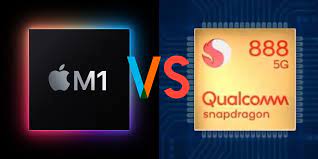
Qualcomm Snapdragon 888 vs Apple M1
Apple M1 vs Qualcomm Snapdragon 888
Comparing the Qualcomm Snapdragon 888 and the Apple M1 is a bit like comparing apples to oranges (pun intended) because they are designed for entirely different devices and use cases. However, I can provide a general overview of their key features and differences:
Qualcomm Snapdragon 888:
1. Mobile Processor: The Snapdragon 888 is designed for mobile devices, particularly high-end smartphones. It is one of Qualcomm’s flagship mobile processors, offering top-tier performance for smartphones and other mobile gadgets.
2. CPU: The Snapdragon 888 features an octa-core CPU with a tri-cluster architecture, including one high-performance core, three performance cores, and four power-efficient cores. It is optimized for power efficiency and multitasking.
3. GPU: It comes with the Adreno 660 GPU, which is designed to provide excellent graphics performance for gaming and other visually demanding tasks on mobile devices.
4. AI Capabilities: The Snapdragon 888 includes the Hexagon 780 AI processor, delivering powerful AI performance for various AI-related tasks and features.
5. 5G Connectivity: The Snapdragon 888 integrates a 5G modem, providing support for the latest 5G networks, enabling faster data speeds and lower latency on compatible devices.
Apple M1:
1. Laptop/Desktop Processor: The Apple M1 is designed for use in Apple’s laptop and desktop devices, particularly the MacBook Air, MacBook Pro, and Mac Mini. It is part of Apple’s transition from using Intel processors to their own custom-designed chips.
2. CPU: The M1 chip features an octa-core CPU with four high-performance cores and four power-efficient cores. It is optimized for performance and energy efficiency, providing impressive power and battery life for Mac devices.
3. GPU: Apple has integrated its own custom-designed GPU into the M1 chip, delivering powerful graphics performance for professional applications and video editing.
4. AI Capabilities: The M1 chip includes a dedicated 16-core Neural Engine, providing exceptional AI processing capabilities for tasks like machine learning and image processing.
5. Unified Memory Architecture: One notable feature of the M1 chip is its unified memory architecture, where the CPU, GPU, and other components share the same memory pool, improving overall performance and efficiency.
In summary, the Qualcomm Snapdragon 888 is a high-end mobile processor for smartphones, while the Apple M1 is a laptop/desktop processor designed for Mac devices. Both chips are powerful in their respective domains and deliver excellent performance. However, they serve different markets and have different optimization focuses, with the M1 being tailored specifically for Apple’s macOS ecosystem.
